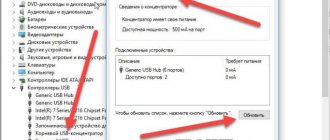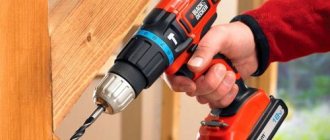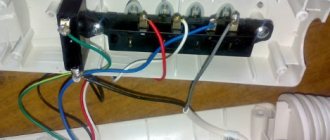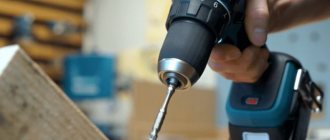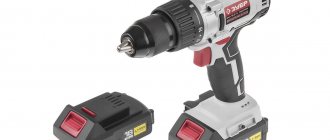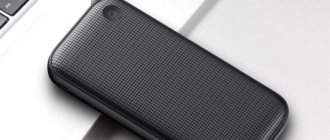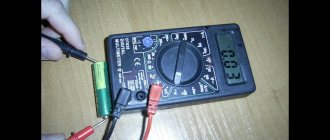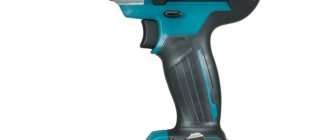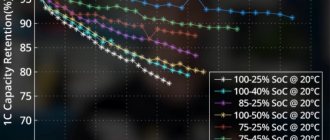A screwdriver is an electric tool that is designed not only for tightening or unscrewing self-tapping screws, screws and other fasteners, but also for drilling holes. A device operating from the mains cannot be used in all places, and in addition, working with such a device is not very convenient, since the cord always gets in the way. To rid yourself of these shortcomings, you need to purchase a screwdriver with a battery. With such equipment you can perform work anywhere and not depend on the presence of an outlet in the house.
The main element of such screwdrivers is the battery, which allows the device to function autonomously. However, after a certain time, each user of such a tool will have a question about how to properly charge the screwdriver battery, and how long to charge the screwdriver battery.
Next, we will talk about what a screwdriver with a battery is, how to charge the battery, how long it takes to charge a screwdriver battery, what are the features of charging a screwdriver battery, how to charge a screwdriver battery without a charger, and also how to check the battery charge level.
Features and requirements for charging different types of screwdriver batteries
Various screwdriver batteries have a common list of requirements for storing and restoring capacity:
- Carrying out a full charge and discharge cycle once a month.
- Battery discharge taking into account charging breaks. The duration ratio should be the same, i.e. After every 20 minutes of operation, the screwdriver should be allowed to “rest”.
- Conducting “training” at least 6 times in six months, each type of battery has its own training conditions.
- Storage at a comfortable temperature of about 15 °C.
Do not allow the screwdriver battery to become deeply discharged when the multimeter shows 0% charge.
When restoring capacity, one should not forget about the “memory effect”. Its principle is based on the premature onset of the loading phase. The screwdriver’s battery is able to “remember” the previous cycle and charge the next time according to the same principle as the last. This does not apply to the Li-ion type of batteries; in them this effect is not expressed at all.
Checking the charge with a multimeter
A deep discharge triggers destructive processes and reduces the energy capacity of the screwdriver battery. Also, you should not try to restore the capacity above 100%, because the chemical components of the battery will decompose. The average number of cycles for a nickel-cadmium battery is 2000. For lithium-ion batteries, this number increases to 3000, for nickel-metal hydride batteries – up to 1500 cycles.
Nickel-cadmium
Nickel-cadmium type batteries (NI CD) for screwdrivers are subject to a “memory effect”, which will lead to a decrease in volume and discharge if improperly restored. Nickel ones tolerate deep discharge easier.
Nickel-cadmium battery
The charger should be selected in accordance with the capacity of the nickel-cadmium battery. Most have a capacity of 1 C, so the charge current should be 1 A.
The design of the nickel-cadmium type rechargeable battery for a screwdriver allows the capacity to be restored at temperatures from 0°C to 40°C; when the threshold is lowered, the pressure will increase and the shell will swell. The capacitance decreases due to the fact that the negative electrode ceases to allow oxygen to pass through due to freezing.
Nickel metal hydride
Nickel - metal hydride type of battery appeared after nickel-cadmium. The scientists' goal was to reduce the "memory effect" that was excessively expressed in Ni-Cd.
Nickel Metal Hydride Power Supplies
The “memory effect” was weakened, but this type of battery received several disadvantages because of this:
- Pronounced self-discharge. With prolonged non-use, the number of discharge and charge cycles decreases.
- Weakness to deep discharge.
- Reduced number of recovery cycles compared to nickel batteries.
The most important thing is to prevent the nickel-metal hydride battery from overheating during restoration and maintain a minimum charge level during storage. Before storing the battery, use a multimeter to measure the current charge level of the battery. It must be at least 30 percent, otherwise after “coming out of hibernation” the battery may stop responding to power sources. If this happens, then under no circumstances subject the battery to a deep discharge.
Ni-MH rechargeable batteries are often used in construction screwdrivers, which are used daily and lose their functionality during long-term storage.
Lithium-ion
Lithium ion, the most modern and expensive type of battery for a screwdriver, is Li-ion, and is not subject to the “memory effect.”
Lithium batteries
It is imperative to carry out discharge and charge training cycles every month so that the electrolyte is always fully utilized. Lithium-ion screwdriver batteries cannot withstand charging at temperatures above 55°C, the recommended temperature range is from +10°C to +20°C, and also cannot withstand deep discharge and overcharging. The electronic circuits of lithium-ion batteries contain controller elements that regulate the operation of each individual part.
Li-ion charge-discharge controller
Li-ion batteries have built-in fuses that regulate the charging current and voltage parameter at both stages of charging. The charger automatically turns off when the charging current drops to 0.05 C.
Features of use
Nickel-cadmium coulometric charging efficiency is about 83% for fast charging (C/1 to C/0.24) and 63% for C/5 charging. This means that at C/1 you should be using 120 amp-hours at every 100 amp hours you receive. The slower you charge, the worse it gets. In C/10 it is 55%, in C/20 he can get less than 50%. (These numbers are just to give you an idea, battery manufacturers vary).
When the charge is complete, oxygen begins to be generated at the nickel electrode. This oxygen diffuses through the separator and reacts with the cadmium electrode to form cadmium hydroxide. This causes a drop in cell voltage, which can be used to determine the end of the charge. This so-called minus delta V/delta t kick, which indicates the end of the charge, is much less pronounced in NiMH than NiCad and is very temperature dependent. Many of the chargers listed here use a complex algorithm that uses -deltaV to accurately charge NiMH and NiCad packs.
Time until the screwdriver battery is fully charged and its main stages
Screwdriver batteries have 2 main charging stages:
- Initial phase. After connecting the charger to the mains, current is supplied to the terminals, then it is stabilized by a transistor or resistor stabilizer. The charge recovery current increases to 200% of the battery capacity.
Multimeter readings during active battery operation
- Final phase. After the charge restoration is completed, there is a gradual decrease in voltage and a decrease in current at the terminals. The final phase may occur when Delta Peak is triggered - a program that automatically stops charging when the maximum permissible voltage is exceeded. The value can be adjusted in many Ni-Cd, Ni-MH, Li-ion batteries.
Each electric screwdriver comes with instructions that usually indicate the average time to restore the battery charge from 0% to 100%. The period may vary depending on external conditions, type of charger, wear and quality of the battery. The indicator on the screwdriver body turns green when the tool is charged.
The average time to fully charge a drill-driver battery ranges from 30 minutes to 7 hours. Nickel-cadmium batteries take the longest to charge. In more expensive Li-ion battery models, fast charging systems are installed. Their volume is completely restored on average within 1 hour of the cycle.
Chargers for screwdrivers are standard and pulse.
- Standard ones are used for small batteries used at home. They rarely have a fast charging system built into them, so full recovery occurs in 3-7 hours.
- Pulse ones can charge a screwdriver battery in 30-90 minutes. The time until complete recovery depends on the type of battery only indirectly.
Example of a pulse memory circuit
The influence of external factors on the charging of screwdriver batteries
Regardless of the type of battery, the operating conditions, taking into account the influence of external factors, do not change:
- The battery for a screwdriver must be charged at a temperature from +10°C to +30°C. The minimum permissible temperature is +5°C; lower values will cause the case to freeze. Do not wet the charger during operation. Do not allow the battery to come into contact with wet objects, rain or snow. Increased air humidity will lead to a decrease in electrical conductivity and breakdown.
- Do not allow direct sunlight to hit the battery, so as not to provoke an increase in the temperature of the case and further overheating. Also, due to exposure to sunlight, metal ions begin to come into mutual contact, which gradually reduces the number of charge and discharge cycles. If you do not take into account external factors when restoring the battery charge, it will lead to breakdown in the near future.
Battery charging too fast
The average battery charging time for a 12 Volt screwdriver is 2-3 hours. If the process accelerates, the battery capacity has decreased. Naturally, this process occurs within 5-7 years, and if charging rules are not followed, within 1-2 years.
Tools
Among power tools, both household and professional, a screwdriver is one of the most popular. With its help you can not only unscrew and screw in self-tapping screws, but also drill holes. Tools powered by the mains cannot be used always and everywhere, and the cord always interferes with the work. Cordless screwdrivers are free from these disadvantages. You can move freely with them and not depend on the presence of an outlet in the room.
An important element of every cordless tool is the battery, which allows you to work with it autonomously. This is very convenient, but sooner or later every owner of such a power tool faces the question of how to charge the screwdriver battery.
How to properly charge a new battery for the first time and during training
After purchasing a new battery or screwdriver, the battery will not be fully charged. This problem is easily solved by conducting training cycles. It is recommended to carry out a full 3-5 cycles of charging and discharging the battery. The lithium-ion battery for a screwdriver is more susceptible to deep discharge, and therefore requires special measurements and procedures before use. Before using a Li-ion battery for the first time:
- Pick up a multimeter and check the current residual charge. The approximate value should be in the range of 20% to 30%.
- Depending on the values obtained using a multimeter, discharge the battery to a value of 20%.
- Place the unit on charge until it is fully charged.
When training batteries, the charger must not be connected via an extension cord. It is best to place the charger next to the input cable to slightly increase the incoming voltage. A new battery should be charged at a temperature of around 20-25°C, in a dry room.
Charging a screwdriver battery requires constant visual monitoring, because the battery may behave unpredictably the first time: overheating or swelling of the case indicates a manufacturing defect. It is important to turn off the charger when the charge level reaches 100% and ensure all external conditions, including air humidity. When performing a discharge training cycle, you should limit the incoming current to 0.1 C.
Swollen battery
Checking the battery condition with a multimeter
If the battery for a screwdriver discharges quickly or does not work, then you do not need to immediately go out and buy a new battery. You can find out the reason for the malfunction yourself. To do this, you will need a tester or other similar device. In addition, you will need the following tools:
- soldering iron;
- pliers;
- screwdriver;
- knife
To find out the cause of a battery malfunction, you must first verify that the charger is working. This is done as follows:
- include multimer;
- put the device in constant voltage mode;
- connect the probes to the appropriate sockets;
- compare the obtained data with the nominal ones indicated in the instructions;
- if the indicators are different, then the adapter is taken for repair or a new one is purchased.
To make sure the battery is working properly, do the following:
- recharge the battery to 100%;
- check the battery output voltage with a measuring device;
- if the nominal data does not match the current ones, then the battery is disassembled and all the banks are taken out;
- if there are visually no faulty banks, then their output voltage is checked, but before that you need to unsolder the circuit using a soldering iron;
- additional ones are connected to the banks one by one. load for the same time, and on which bank the largest voltage drop occurred, then that one is non-working.
In addition, when checking the battery, it must be taken into account that for nickel batteries the output voltage should be from 1.2 volts to 1.4 volts, and for lithium batteries - from 3.6 volts to 3.8 volts. Having found a non-working jar, it needs to be replaced with a new one.
How to store a screwdriver battery
Storage conditions vary depending on the type of battery. Before storing a screwdriver or battery, you need to perform some procedures.
Lithium-ion
Since the lithium-ion type of screwdriver battery is not subject to the memory effect, it can be left for storage at any charge level, but a result of 40-50% would be desirable, provided that the battery will not be used for 1-1.5 months. After this period, you should remove the battery from the storage compartment and recharge it again to 40-50%. Full discharge must not be allowed. Otherwise, the protective controllers will fail.
Correctly charge lithium-ion screwdriver batteries immediately after long-term storage. You need to charge the battery to 100%. Li-ion batteries have a low level of self-discharge; shelf life depends more on external conditions.
Nickel-cadmium
Before leaving nickel-cadmium batteries for long-term storage, 3-5 complete charge and discharge cycles should be carried out. Store at zero charge, as it easily tolerates deep discharge. After storage is completed, several complete training cycles of discharging and charging are carried out with the nickel-cadmium battery. Before first use, the battery must be charged 100%.
Nickel metal hydride
Nickel metal hydride is the most unsuitable type of battery for household tools, including screwdrivers. They are subject to rapid self-discharge and require constant recharging during storage. Every month, the charge level when checked with a multimeter should be at least 30%. At the end of the storage period, the nickel metal hydride battery must be fully charged within 24 hours. If this is not done, the full charge and discharge cycle will drop to ~500 within a short time.
Features of charging of one type or another + (Video)
The initial charging of the screwdriver is considered a very significant factor, since it determines whether the full charge capacity becomes active or not. Any type of battery has its own characteristics of primary charging. The process of recharging a nickel-cadmium battery is somewhat complicated. Initially, it needs to be recharged three times in a row, and so that the charge capacity remains full.
It is recommended to completely discharge the nickel-metal hydride type for the first time, and also fully charge it. The complete charging/discharging cycle is repeated 4-5 times, then you can safely charge and discharge the battery regardless of how full the container is.
There are no special rules for lithium-ion; the capacity remains unchanged for a long time.
Advice! Do not allow the power supply to overheat above 50 degrees.
How to charge a screwdriver battery without a charger
If the charger fails or is lost, then to work with the battery you can use:
- universal memory;
- external power supply;
- A charger for another battery, for example, a car battery.
Universal charger
The advantage of a car battery charger is the magnitude of the output voltage. It does not exceed 16.5 Volts, so the charger is suitable for both 16 Volt and 18 Volt screwdrivers.
If the original factory charger is lost, then you should use a universal charger. It regulates the voltage, current and resistance values. You can adjust the parameters yourself according to the instructions.
Original memory
Various DC sources are also suitable. The main condition is the presence of a higher voltage relative to the screwdriver battery. Exceeding the nominal value is permissible by 10-20%. Nickel-cadmium and nickel-metal hydride batteries will not withstand a charge current of more than 0.5 C, and lithium-ion batteries will not withstand more than 1 C. The current values will have to be adjusted independently, and you will also have to monitor the temperature of the battery being charged.
Self-charging of the battery using an external power source
Restoring the capacity of a screwdriver battery using a power source requires knowledge of critical temperatures, input voltage and current parameters. If you don't follow them, an overcharge will occur. The pressure inside the battery will increase and the electrolyte will begin to decompose, which can lead to a rupture.
You can use external power sources only if there are no other ways to charge the battery. It is important to observe terminal polarity and safety precautions. You can only hold on to insulated rubberized wires that do not allow electric current to pass through.
If the screwdriver battery does not charge
There are several reasons why the screwdriver battery does not charge. The problem lies in the elementary wear of the battery, as well as the violation of the integrity of the contacts of the charger. Then it should be disassembled and the terminals bent in the desired direction.
The contacts may oxidize and become dirty. Failure to comply with storage conditions will lead to disruption of the charging cycle; the charge recovery time may either increase or decrease. The contacts of the battery and charger must be periodically wiped with special cleaning pastes.
Worn out power supply
The cause of failure of nickel-cadmium and nickel-metal hydride batteries may be the memory effect. If the battery is repeatedly charged before the energy reserves expire, then the number of charging cycles will gradually decrease. Eventually a breakdown occurs. Over time, the battery's charging and discharging cycles end. The Li-ion type has the greatest durability; the nickel-metal hydride battery lasts less long.
